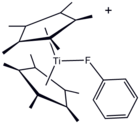Fluorobenzene
| |||
| Names | |||
|---|---|---|---|
| IUPAC name
Fluorobenzene
| |||
| Other names
Phenyl fluoride
Monofluorobenzene | |||
| Identifiers | |||
3D model (JSmol)
|
|||
| ChEBI | |||
| ChEMBL | |||
| ChemSpider | |||
| ECHA InfoCard | 100.006.657 | ||
| KEGG | |||
PubChem CID
|
|||
CompTox Dashboard (EPA)
|
|||
| |||
| |||
| Properties | |||
| C6H5F | |||
| Molar mass | 96.103 | ||
| Appearance | Colorless liquid | ||
| Density | 1.025 g/mL, liquid | ||
| Melting point | −44 °C | ||
| Boiling point | 84–85 °C | ||
| low | |||
| Structure | |||
| Planar | |||
| Hazards | |||
| NFPA 704 (fire diamond) | |||
| Related compounds | |||
Except where otherwise noted, data are given for materials in their standard state (at 25 °C [77 °F], 100 kPa).
| |||
Fluorobenzene is the chemical compound with the formula C6H5F, often abbreviated PhF. This species is a derivative of benzene, with a single fluorine atom attached. Its melting point is -44 °C, which is lower than that of benzene, indicative of the remarkable effect of fluorination on the intermolecular interactions as seen throughout organofluorine chemistry. In contrast, the boiling points of PhF and benzene differ by only 4 °C.
Preparation
On the laboratory scale, PhF is conveniently prepared by the thermal decomposition of the benzenediazonium tetrafluoroborate[1]
According to the procedure, solid [PhN2]BF4 is heated with a flame to initiate an exothermic reaction that affords two volatile products, PhF and BF3, which are readily separated because of their differing boiling points.
PhF was first reported in 1886 by O. Wallach at the University of Bonn, who prepared the compound in two steps, starting also with a phenyldiazonium salt. The diazonium chloride was first converted to its piperidinide, which in turn was cleaved using hydrofluoric acid.
- [PhN2]Cl + 2 C5H10NH → PhN=N-NC5H10 + [C5H10NH2]Cl
- PhN=N-NC5H10 + 2 HF → PhF + N2 + [C5H10NH2]F
An interesting historical note: in Wallach’s era, the element fluorine was symbolized with “Fl”. Thus, his procedure is subtitled “Fluorbenzol, C6H5Fl”.[2]
The technical synthesis is by the reaction of cyclopentadiene with difluorocarbene. The initially formed cyclopropane undergoes a ring expansion and subsequent elimination of hydrogen fluoride.
Reactions
PhF is a relatively inert compound because the C–F bond is very strong. PhF is a useful solvent for highly reactive species, but a metal complex has been crystallized.[3]
Fluorination of fluorobenzene gives mainly 1,2-difluorobenzene.
References
- ^ Flood, D. T. (1943). "Fluorobenzene". Organic Syntheses; Collected Volumes, vol. 2, p. 295..
- ^ Wallach, O. “Über einen Weg zur leichten Gewinnung organischer Fluorverbindungen” (Concerning a method for easily preparing organic fluorine compounds) Justus Liebig's Annalen der Chemie, 1886, Volume 235, p. 255–271; doi:10.1002/jlac.18862350303
- ^ R.N. Perutz and T. Braun “Transition Metal-mediated C–F Bond Activation” Comprehensive Organometallic Chemistry III, 2007, Volume 1, p. 725–758; doi:10.1016/B0-08-045047-4/00028-5.




